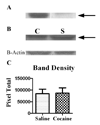Cocaine withdrawal-induced trafficking of delta-opioid receptors in rat nucleus accumbens
- PMID: 18417105
- PMCID: PMC2474759
- DOI: 10.1016/j.brainres.2008.02.105
Cocaine withdrawal-induced trafficking of delta-opioid receptors in rat nucleus accumbens
Abstract
Interactions between the opioidergic and dopaminergic systems in the nucleus accumbens (NAcb) play a critical role in mediating cocaine withdrawal-induced effects on cell signaling and behavior. In support of this, increased activation of striatal dopamine-D1 receptors (D1R) results in desensitization of delta-opioid receptor (DOR) signaling through adenylyl cyclase during early cocaine withdrawal. A potential cellular substrate underlying receptor desensitization is receptor internalization. The present study examined the effect of cocaine withdrawal on subcellular localization of DOR in dendrites of the NAcb core (NAcbC) and shell (NAcbS) using immunoelectron microscopy. Female and male rats received binge-pattern cocaine or saline for 14 days and subsequently underwent 48 h withdrawal. Animals were transcardially perfused and tissue sections were processed for immunogold-silver localization of DOR. Semi-quantitative analysis revealed that cocaine withdrawal caused an increase in the percentage of DOR localized intracellularly in the NAcbS of male and female rats and the NAcbC of male rats compared to saline controls. In contrast, in the NAcbC of female rats, there was an increase in DOR associated with the plasma membrane following cocaine withdrawal. To determine whether modulation of D1R could directly impact DOR containing neurons, the hypothesis that DOR and D1R co-exist in common neurons of the NAcb was examined in naïve rats. Semi-quantitative analysis revealed a subset of profiles containing both DOR and D1R immunoreactivities. The present findings demonstrate a redistribution of DOR in the NAcb following cocaine withdrawal and provide anatomical evidence supporting D1R regulation of DOR function in a subset of NAcb neurons.
Figures






Similar articles
-
Dopamine-D1 and delta-opioid receptors co-exist in rat striatal neurons.Neurosci Lett. 2006 May 22;399(3):191-6. doi: 10.1016/j.neulet.2006.02.027. Epub 2006 Mar 6. Neurosci Lett. 2006. PMID: 16517070
-
Role of mu- and delta-opioid receptors in the nucleus accumbens in cocaine-seeking behavior.Neuropsychopharmacology. 2009 Jul;34(8):1946-57. doi: 10.1038/npp.2009.28. Epub 2009 Mar 11. Neuropsychopharmacology. 2009. PMID: 19279569 Free PMC article.
-
Renewed cocaine exposure produces transient alterations in nucleus accumbens AMPA receptor-mediated behavior.J Neurosci. 2008 Nov 26;28(48):12808-14. doi: 10.1523/JNEUROSCI.2060-08.2008. J Neurosci. 2008. PMID: 19036973 Free PMC article.
-
Cellular sites for activation of delta-opioid receptors in the rat nucleus accumbens shell: relationship with Met5-enkephalin.J Neurosci. 1998 Mar 1;18(5):1923-33. doi: 10.1523/JNEUROSCI.18-05-01923.1998. J Neurosci. 1998. PMID: 9465017 Free PMC article.
-
Comparison of cocaine- and methamphetamine-evoked dopamine and glutamate overflow in somatodendritic and terminal field regions of the rat brain during acute, chronic, and early withdrawal conditions.Ann N Y Acad Sci. 2001 Jun;937:93-120. doi: 10.1111/j.1749-6632.2001.tb03560.x. Ann N Y Acad Sci. 2001. PMID: 11458542 Review.
Cited by
-
Delta-opioid receptor expression in the ventral tegmental area protects against elevated alcohol consumption.J Neurosci. 2008 Nov 26;28(48):12672-81. doi: 10.1523/JNEUROSCI.4569-08.2008. J Neurosci. 2008. PMID: 19036960 Free PMC article.
-
Localization of the delta opioid receptor and corticotropin-releasing factor in the amygdalar complex: role in anxiety.Brain Struct Funct. 2017 Mar;222(2):1007-1026. doi: 10.1007/s00429-016-1261-6. Epub 2016 Jul 4. Brain Struct Funct. 2017. PMID: 27376372 Free PMC article.
-
Genetic variation in OPRD1 and the response to treatment for opioid dependence with buprenorphine in European-American females.Pharmacogenomics J. 2014 Jun;14(3):303-8. doi: 10.1038/tpj.2013.30. Epub 2013 Oct 15. Pharmacogenomics J. 2014. PMID: 24126707 Free PMC article.
-
Disease-specific heteromerization of G-protein-coupled receptors that target drugs of abuse.Prog Mol Biol Transl Sci. 2013;117:207-65. doi: 10.1016/B978-0-12-386931-9.00009-X. Prog Mol Biol Transl Sci. 2013. PMID: 23663971 Free PMC article. Review.
-
Nicotine withdrawal increases stress-associated genes in the nucleus accumbens of female rats in a hormone-dependent manner.Nicotine Tob Res. 2015 Apr;17(4):422-30. doi: 10.1093/ntr/ntu278. Epub 2015 Mar 11. Nicotine Tob Res. 2015. PMID: 25762751 Free PMC article.
References
-
- Ambrose LM, Unterwald EM, Van Bockstaele EJ. Ultrastructural evidence for co-localization of dopamine D2 and mu-opioid receptors in the rat dorsolateral striatum. Anat Rec. 2004;279A:583–591. - PubMed
-
- Ambrose LM, Gallagher SM, Unterwald EM, Van Bockstaele EJ. Dopamine-D1 and delta-opioid receptors co-exist in rat striatal neurons. Neurosci Lett. 2006;399:191–196. - PubMed
-
- Becker JB. Gender differences in dopaminergic function in striatum and nucleus accumbens. Pharmacol Biochem Behav. 1999;64:803–812. - PubMed
Publication types
MeSH terms
Substances
Grants and funding
LinkOut - more resources
Full Text Sources
Medical

